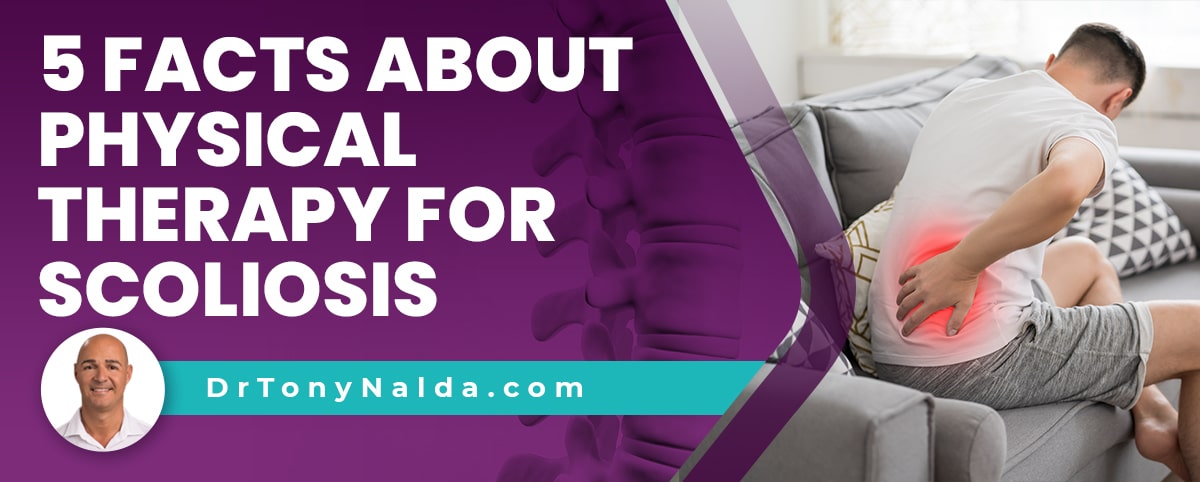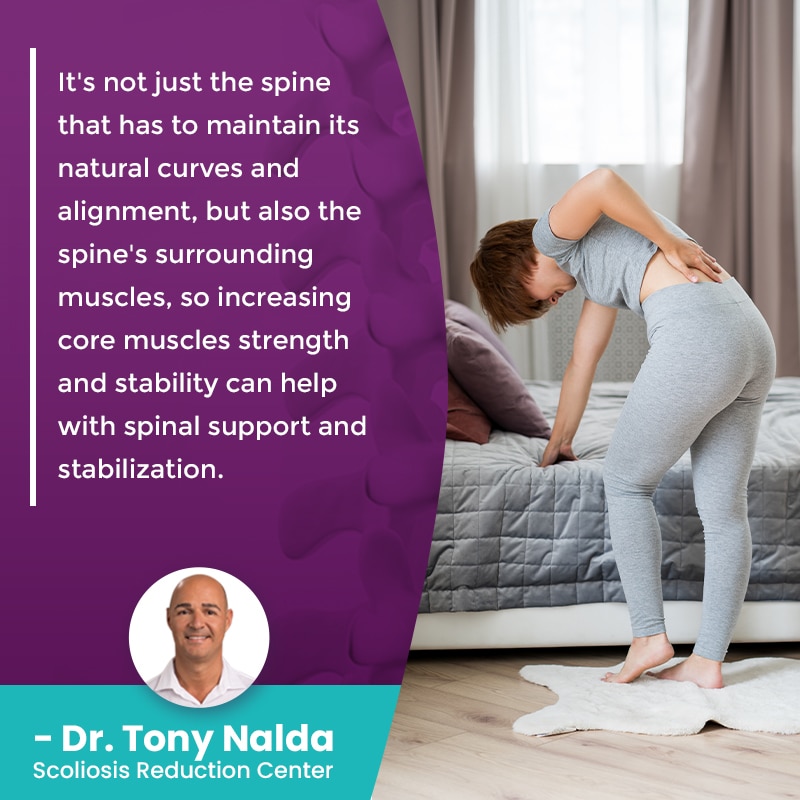5 Facts About Physical Therapy for Scoliosis [ Must Know ]

It's important for people diagnosed with scoliosis to understand the pros and cons of the different treatment options available because how scoliosis is treated will shape long-term spinal health. As such a complex condition, it's beyond the scope of general medicine and requires a specialized treatment plan and approach.
Physical therapy for scoliosis is one facet of treatment. No amount of physical therapy on its own is enough for correcting scoliosis, but when scoliosis-specific and combined with other conservative treatment disciplines, it can help achieve corrective results.
Before addressing 5 interesting facts about physical therapy for scoliosis treatment, let's first talk generally about how scoliosis affects the body.
Table of Contents
How Scoliosis Affects the Body
Scoliosis involves the development of an unnatural sideways-bending and rotating curvature of the spine, and as a progressive condition, its nature is to get worse over time.
The condition ranges widely in severity from mild to moderate and severe to very severe scoliosis, and there are also different condition types, including idiopathic scoliosis, neuromuscular scoliosis, congenital scoliosis, and degenerative scoliosis.
Scoliosis introduces a lot of uneven forces to the body, and as scoliosis progresses, the size of the unnatural spinal curve is increasing, as are the condition's uneven forces, and their effects.
As scoliosis develops and progresses, it causes the spine to become misaligned, and that doesn't just affect the spine, but also its surrounding muscles and nerves, and the entire body.
Scoliosis causes postural changes that disrupt the body's overall symmetry, and in addition to uneven shoulders, hips, shoulder blades, the development of a rib arch, and arms and legs that appear to hang at different lengths, changes to gait, balance, and coordination are also common condition effects.
Scoliosis doesn't become a compressive condition until skeletal maturity has been reached, which is why the condition isn't generally known to cause noticeable back pain and pain that radiates into the extremities due to nerve compression in children; pain is the main symptom that brings adults in to see me for a diagnosis and treatment.
Prior to reaching skeletal maturity, the constant lengthening motion of a growing spine counteracts the compressive force of the unnatural spinal curve.
As scoliosis progresses, its effects are likely to become more noticeable, and the condition is becoming more complex to treat, hence the importance of a proactive treatment plan specific to each patient that includes physical therapy.
Let's explore 5 facts about physical therapy as a facet of scoliosis treatment.
1) Physical Therapy is Helpful for All Severity Levels of Scoliosis
As mentioned, scoliosis ranges widely in severity from mild to moderate and severe to very severe, and physical therapy treatments can be helpful for all severity levels.
As a progressive condition, how severe a patient's scoliosis is at the time of diagnosis doesn't indicate that's where it will stay; only proactive treatment can work towards counteracting the condition's progressive nature.
While the intensity and types of exercises, stretches, and strength training included in physical therapy will vary based on a number of variables, condition severity being one of them, the benefit of physical therapy in scoliosis treatment is clear.
 It's not just the spine that has to maintain its natural curves and alignment, but also the spine's surrounding muscles, so increasing core muscles strength and stability can help with spinal support and stabilization.
It's not just the spine that has to maintain its natural curves and alignment, but also the spine's surrounding muscles, so increasing core muscles strength and stability can help with spinal support and stabilization.
2) There is a Significant Difference Between General Physical Therapy and Scoliosis-Specific Physical Therapy
When it comes to the complexities of treating a progressive structural 3-dimensional spinal condition like scoliosis, treatment disciplines have to be condition-specific to ensure specific results.
The complex nature of scoliosis necessitates the complete customization of potentially-effective treatment plans; scoliosis treatment plans have to be crafted by specialists trained in multiple different scoliosis-specific treatment modalities.
There was a time when the place of exercise in scoliosis treatment was questioned, but we have since learned that when scoliosis-specific, scoliosis exercises can help augment corrective treatment results in a number of ways.
General physical therapy can help with increasing core strength and stability, but when it comes to the power of an exercise program with corrective potential, it has to be scoliosis-specific.
Treating scoliosis effectively involves a lot more than adjusting the position of the spine; it also has to impact the spine's surrounding muscles, nerves, and improve sensorimotor integration, and when scoliosis-specific, physical therapy can help increase core strength, stability, relieve nerve tension, and activate certain areas of the brain for enhanced brain-body communication.
3) Physical Therapy Can Help Treat Patients of Any Age
While there are certain facets of treatment, or focuses of treatment, that change amongst different age groups, physical therapy can easily be adjusted to address the unique challenges associated with treating scoliosis patients of any age.
Physical therapy can be modified to suit all age groups, which is helpful as scoliosis affects babies to the elderly and every age in between.
While the type and intensity of physical therapy treatment plans will vary based on patient age, and a number of other factors for that matter, there is no age at which physical therapy is deemed unsafe or unhelpful in scoliosis treatment.
4) Scoliosis-Specific Physical Therapy is More Intensive than General Physical Therapy
In order for physical therapy to have corrective potential in scoliosis treatment, it has to be applied in shorter bursts of intense treatment, rather than slow changes facilitated over time.
The therapeutic benefits of physical therapy have to counteract the condition's progressive nature, so has to involve quicker results achieved through a more intensive exercise/therapy regime.
Patients are never pushed past their limits, but they are challenged to undergo more therapy in shorter periods of time as this is what the condition's progressive nature necessitates and responds to.
5) Physical Therapy Should Only Be One Facet of Treatment in a Multi-Faceted Approach
It's important for patients to understand that no one type of treatment is powerful enough to impact scoliosis on multiple levels the way it needs to for long-term sustainable treatment results.
As a progressive condition, treating scoliosis doesn't have the goal of curing scoliosis, but is more focused on how to effectively manage on ongoing progressive condition.
There are two main scoliosis treatment approaches: traditional and conservative. Traditional scoliosis treatment offers patients a surgical response, while conservative treatment is integrative and chiropractic-centered.
A conservative treatment plan is customized to address key patient/condition variables by integrating multiple condition-specific treatment disciplines to impact conditions on multiple levels.
Physical therapy for scoliosis has to follow chiropractic care that includes a series of techniques and manual adjustments to adjust the position of the curve's most-tilted vertebrae: impacting the condition on a structural level.
Corrective bracing is another facet of treatment when addressing childhood scoliosis, and rehabilitation treatment is also ongoing and can include continued chiropractic care and a series of custom-prescribed home exercises to further heal and stabilize the spine.
So when combined, these different scoliosis-specific treatment disciplines can complement one another to facilitate corrective results.
Conclusion
When physical therapy is scoliosis-specific, it can help prepare the spine for treatment by increasing spinal flexibility; it can help increase the strength of the abdominal muscles so scoliotic spines can receive optimal support and stabilization, manage pain, encourage proper posture, improve range of motion, spinal flexibility, and sensorimotor integration.
Physical therapy exercises crafted by a physical therapist that specializes in scoliosis exercises and treatment has the potential to help reduce scoliotic spinal curves through making the spine more responsive to manual therapy, the body stronger and better able to maintain core stability and strength, and improving brain-body communication for better posture and body positioning.
According to the Scoliosis Research society, there are currently close to seven million people living with scoliosis in the United States alone, and as the leading spinal condition amongst school-aged children, it warrants awareness.
Physical therapy is a versatile form of treatment that is helpful when treating all severity levels and types of scoliosis, not to mention can easily be adjusted to suit a patient's age-related ability.
From the Schroth method, Schroth exercises to SEAS, the best exercises for scoliosis are those that help create an environment inside the body that's conducive to healing, while helping to facilitate corrective treatment results.
Here at the Scoliosis Reduction Center, I believe in helping patients improve quality of life by reducing scoliotic curves on a structural level, and scoliosis-specific physical therapy is always a key facet of my treatment approach.
Dr. Tony Nalda
DOCTOR OF CHIROPRACTIC
After receiving an undergraduate degree in psychology and his Doctorate of Chiropractic from Life University, Dr. Nalda settled in Celebration, Florida and proceeded to build one of Central Florida’s most successful chiropractic clinics.
His experience with patients suffering from scoliosis, and the confusion and frustration they faced, led him to seek a specialty in scoliosis care. In 2006 he completed his Intensive Care Certification from CLEAR Institute, a leading scoliosis educational and certification center.
About Dr. Tony Nalda
 Ready to explore scoliosis treatment? Contact Us Now
Ready to explore scoliosis treatment? Contact Us Now





